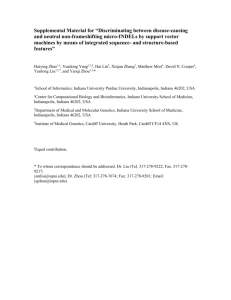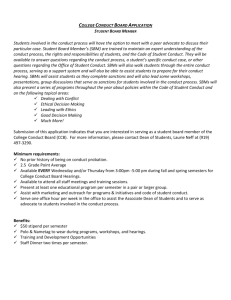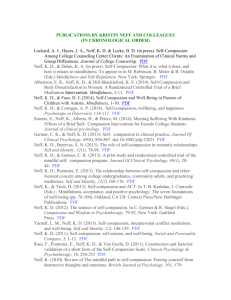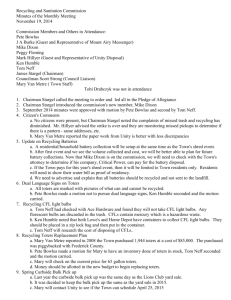Pat Neff Script for KWBU/NPR
advertisement
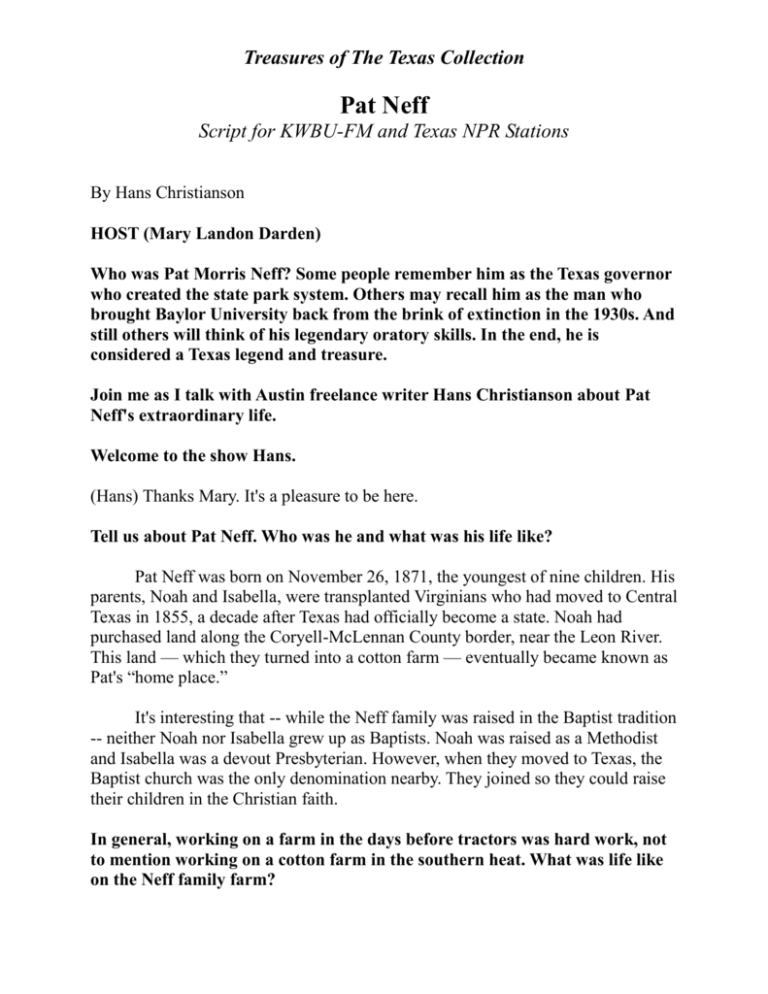
Treasures of The Texas Collection Pat Neff Script for KWBU-FM and Texas NPR Stations By Hans Christianson HOST (Mary Landon Darden) Who was Pat Morris Neff? Some people remember him as the Texas governor who created the state park system. Others may recall him as the man who brought Baylor University back from the brink of extinction in the 1930s. And still others will think of his legendary oratory skills. In the end, he is considered a Texas legend and treasure. Join me as I talk with Austin freelance writer Hans Christianson about Pat Neff's extraordinary life. Welcome to the show Hans. (Hans) Thanks Mary. It's a pleasure to be here. Tell us about Pat Neff. Who was he and what was his life like? Pat Neff was born on November 26, 1871, the youngest of nine children. His parents, Noah and Isabella, were transplanted Virginians who had moved to Central Texas in 1855, a decade after Texas had officially become a state. Noah had purchased land along the Coryell-McLennan County border, near the Leon River. This land — which they turned into a cotton farm — eventually became known as Pat's “home place.” It's interesting that -- while the Neff family was raised in the Baptist tradition -- neither Noah nor Isabella grew up as Baptists. Noah was raised as a Methodist and Isabella was a devout Presbyterian. However, when they moved to Texas, the Baptist church was the only denomination nearby. They joined so they could raise their children in the Christian faith. In general, working on a farm in the days before tractors was hard work, not to mention working on a cotton farm in the southern heat. What was life like on the Neff family farm? Pat Neff 2 The Neffs operated a successful cotton farm, and it was a family affair, too. When the boys were old enough to work, they joined Noah in the fields. They often worked from sunset to sundown, which averaged about 12 hours a day, six days a week. Being good Christians, they rested from their labor on Sunday. Pat's main chore — other than picking cotton — was working with the hogs. Later in life, he credited his patience to this time working with the hogs. Apparently, there's nothing more frustrating than trying to corral hungry hogs in sight of a nearby cornfield. Over the years, the Neff family underwent several tragedies. During a threeyear period, typhoid claimed the lives of two siblings, sister Lizzie and brother Charles, along with his father Noah. Not long after the death of Charles in 1885, another brother, Edward, was arrested for murder but was eventually acquitted. However, in 1888, the Neff name was wounded with the conviction of brother Samuel in the armed robbery of a mail train. There's a story that Pat Neff told often about wearing a dress and sun bonnet as a child? Is that really true? His mother made him wear a dress and a large sun bonnet while he was out in the cotton fields in order to protect his fair skin. This continued until he was around nine or ten-years-old. Since Neff was big for his age, this often caused him to be mistaken for a local, young lady, including a time that he tried to go watch a horse race. He was initially denied entrance on account of his presumed gender, but the matter was quickly resolved upon the revelation that he was, indeed, a boy. I know Pat Neff was initially home schooled, because there wasn't a nearby school for him to attend. What can you tell us about the rest of his schooling? All of the Neff children started out being educated at home by Isabella. As Pat grew older, he attended the newly constructed elementary school at Eagle Springs and later high school in McGregor, Texas. It was during a trip to Waco to deliver cotton that he first saw Baylor University and resolved to one day attend the Baptist institution. That day arrived on December 31, 1888, when he enrolled for the spring 1889 term. His time at Baylor would be a significant time in his life. He met future Baylor President Samuel Brooks, who would become Neff’s first roommate and lifelong friend. He also met his future wife, a young music major from Lovelady, Texas, named Myrtle Manier, or Myrtie, as she liked to be called. Following his Pat Neff 3 graduation in 1894, Pat chose his career path — he would become a lawyer. He didn't go to law school right away though. Didn’t he spend a few years teaching first? Following Neff's graduation from Baylor, he wanted to place his finances in order before he pursued law. After receiving a teaching certificate from the Texas Educational Department in Austin, he found a job at the Southwestern Academy, a new preparatory school in Magnolia, Arkansas. He spent a day with Myrtie in Lovelady, and then went to Magnolia. It would be a year before he would see her again. Neff excelled in the academy, but he had a grueling teaching schedule. The classes included physiology, oratory (one of Neff's specialties), mathematics and Latin. One of his students, a boy named Harvey Couch went on to achieve great, entrepreneurial success in the railroad and energy industries. Couch even became an adviser to U.S. Presidents Roosevelt (which one?) and Hoover. He always credited his success back to Neff's guidance and teaching. By the end of two years, Neff was ready to move back to Texas and pursue his studies in law. There's a great story involving Pat Neff at the University of Texas Law School. Apparently, he was involved in a group called “the rebels”. While Neff was attending law school at the University of Texas, he found himself involved in a historical prank. On March 2, the state of Texas traditionally celebrates its independence from Mexico. In 1897, it was a state holiday, but it wasn't a University of Texas holiday. So, in true rebel fashion, Pat and a few friends decided to change that. On March 1, the planning for the rebellion was underway. The ingredients included an oversized Texas flag, a cannon “borrowed” from the nearby state capital and 45 pounds of gun powder. The next day, they rolled the cannon in front of Old Main and prepared to fire it. The rebels were met by the university's newly installed president and North Carolina native George T. Winston. Instead of punishing the boys, he actually praised them. Neff recalled Winston saying: I was born in the land of liberty, rocked in the cradle of liberty, nursed on the bottle of liberty, and I've had liberty preached to me all my life. But Texas Pat Neff 4 University students take more liberty than anyone I've ever come in contact with. The rebels did fire off the cannon, but it was in a nearby athletic field – a suggestion given to them by Winston. Did Neff ever marry Myrtie? Neff was not in any hurry to get married. He and Myrtie went through a nine-year courtship before tying the knot. For several years, he maintained that he wanted to get through law school and become self-sufficient. Neff also told her in letters that he didn't feel ready for marriage, and often criticized his friends getting married. He described the pending marriages of friends as “crossing the muddy waters.” But even he couldn't hold out forever. Toward the end of the courtship, Myrtie became more forceful and pressed for a wedding date. Neff finally gave in after calling the situation “inevitable” and agreed to get married. The ceremony was on May 31, 1899 in Lovelady, Texas. No one from the Neff family attended the wedding. He pleaded for his mother to make the trip, but she responded that she no longer felt able to travel. What's interesting is that she continued to travel around Texas for the next 20 years. But, she did make it to Baylor to attend his master's degree graduation ceremony the following year. Let's step back a little and talk about how Pat Neff got his start in politics, which apparently was an on-again, off-again affair. After he graduated from law school, Neff moved back to Waco to practice law. He was 25 years old. Since his initial workload was lighter than he might have imagined, he worked on a master's degree at Baylor. The following year, on March 31, 1898, he decided to run for the Texas Legislature. After a successful campaign against six other candidates, Neff was elected in the general election on November 8. He was sworn into the House of Representatives on January 10, 1899. He would go on to serve an additional two terms for a total of six years in the Texas House of Representatives. And during the third term, the 28th legislature, Neff was elected speaker of the house. Pat Neff also enjoyed a short, but often-considered brilliant career as a prosecutor in Waco. What are some of the stories associated with this stage of Pat Neff 5 his career? After he finished his third term in the legislature, he decided to forgo any more statewide offices. In 1903, he accepted the position of assistant county attorney in Waco from his friend and then county attorney O.H. Cross, with whom he had served with in the legislature. Along with prosecuting felonies and misdemeanors, Neff was allowed to continue handling clients in his own private practice. In 1906, Neff assumed the county attorney's position after defeating a primary opponent and running unopposed in the general election. The following year, he would become the president of the Board of Trustees at Baylor. In 1908, he was unanimously elected to a second term. And in 1910, he was elected to an unprecedented third and final term. During his six years as county attorney, Neff tried a total of 352 cases and won all but 16. His oratorical skills often impressed the juries, and one of his closing arguments in a murder case against a man named Alex Johnson was included in an eight-volume series of legal speeches. Neff took pride in leaving the office with virtually zero cases for his successor, compared to the nearly 1,100 pending cases he encountered when he assumed office. It sounds like Neff was a restless overachiever and he must have missed being in politics, because at some point he decide to run for governor. After Neff stepped down from the county attorney's office, he focused on his private practice for the next six years. During this time, he began thinking of entering politics again … this time as governor. Once he made his decision in 1919, nearly a year before the primary election, he began to get the word out to his friends and colleagues of his intention to run for governor. Since Texas was such a heavily Democratic state, the real voting took place in the primaries and runoff elections. After immense campaigning in 1920, Neff secured the party nomination. By the time the general election rolled around in November, it wasn't even a contest. Neff won easily. Pat Neff was a man of many strong convictions. One, in particular, involved questionable beverages. This became sort of an issue, perhaps even a liability during his campaign for governor. Pat Neff 6 When Neff was running for governor, he had a bit of an image problem that he had to overcome. His opposition described him as a “mollycoddle,” claiming he had never shot a gun, baited a hook or drunk anything stronger than Brazos River water. Neff worked at reversing this perception by presenting himself as a hunter and fisherman as he traveled around Texas campaigning. One funny story involves Neff at a duck hunting camp. After a day of hunting, Neff's friends discovered that he had carried an unloaded gun all day long. The next morning, the men decided to play a joke on Neff for his lack of contribution to the hunt. The cook began to dish out plates with cooked duck from the previous day, but when he got to Neff, he served him a plate with a wooden decoy duck. I don't know if Neff thought this was funny. And while Neff was also a lifelong teetotaler, he did recall one incident early in his life when he drank something stronger than Brazos River water. He was traveling out of town with his good friend Samuel Brooks, who convinced him to drink a cup of coffee. After giving into the temptation, Neff would proclaim it to be his first and last cup of coffee. Pat Neff would serve two terms as governor before again retiring from public service. What can you tell us about his time in office? Does any particular legislation stand out? There are a few things from Neff's time as governor that are noteworthy. He worked at cleaning up the prison pardon process, which he felt had been abused by his predecessors. In 1922, he declared martial law and sent Texas National Guard troops and Texas Rangers to Mexia. The town had a population surge after a large oil strike, and became overrun with crime. The martial law stayed in effect for 47 days and resulted in the arrests of more than 600 people. His biggest success is the creation of the statewide park system in Texas. The idea is credited to his mother who donated six acres along the Leon River for public use. Eventually, Neff himself would add more land to the donation and create the Mother Neff State Park. You can see signs for the park along Interstate 35 today. The park system was something that was important to Neff, as evidenced by his campaign kickoff speech in 1922: The State should establish parks, both large and small, throughout her broad Pat Neff 7 boarders. The people should have these breathing spots, where they can enjoy nature in stream and tree, in rock and rill. These are valuable things in this world that do not bear the dollar mark. I understand that Neff started a new tradition among Texas governors. What is the story behind that? Being the good Baptist he was, it's no surprise that Neff left a unique gift behind when he left the governor's mansion in 1925. It was a Bible with an inscription: Presented to my successors in office. He also underlined a passage, Psalm 119:105, which must have been important to him. It reads: Thy word is a lamp unto my feet and a light unto my path. While I don't know if this practice is still in effect, several governors after Neff — including Ma Ferguson, Dan Moody, and James Allred — continued the tradition. Pat Neff's decision to become president of Baylor was not an easy decision to make. What made him accept the presidency? I came across a great story published in 1975 in a Waco newspaper called The Citizen. It was written by one of Neff's former secretaries, a woman named Emma Shirley. She described the dilemma that faced Neff in 1931 when both the University of Texas and Baylor each wanted him to become president of their respective schools. At the time, Neff was serving as the state's railroad commissioner. His initial reply to each school was: I am not a school man, I'm a lawyer. His fans were persistent, particularly those at Baylor. They wrote him letters, and for a short time, he received 50 to 100 letters a day, which he answered personally. The decision breaker was Dr. George Truett, who came to Austin to address the state legislature. After his rousing speech, the two men returned to Neff's office. Along the way, Truett said: Pat Neff 8 Pat, the Lord has put His hand on my shoulder to tell you that you must come to Baylor. It is His will. Neff responded: Truett, my beloved friend, if you say it is the Lord's will, I believe you, I'll come. The two men knelt down together and prayed. The best part about this story is that nearly five decades passed before Shirley shared the encounter with anyone. Taking on this brand new vocation was not an easy task. To add to the challenges, Baylor was in considerable debt when Neff took office. How did he deal with the financial problems? Baylor was in trouble. Enrollment was down and debt was high. No one would lend the institution any money. And, when the Great Depression hit, things got even worse. Neff realized that if he was going to keep Baylor going, he would have to make drastic decisions. Since the board gave him nearly limitless power, Neff started cutting costs any way he could. The first to go were non-essential staff members — electricians, plumbers and secretaries. He also let faculty members go and then hired students to fill staff positions if they accepted tuition credit in place of cash payments. The dormitories were rented out in the summer time to out-of-town visitors, and faculty and staff members were allowed to live in them during the school year. During his first faculty meeting, Neff was described by former history professor Guy B. Harrison as saying: We have no money. We cannot borrow a penny … We don't have money for books … [We must] use a book and repair it until it can't be repaired any more, and then take a brick and lay it on top of it to keep the pages from blowing away. What were some of the creative ways that Pat Neff stimulated enrollment and helped students receive an education? Paying for college had always been a challenge, particularly during the Great Depression. To help students, Neff created a student employment bureau that Pat Neff 9 helped students locate part-time jobs around the city. He also allowed some students to barter for their education. In 1932, two students from Mart, Texas, brought payment in the form of two dairy cows. The animals stayed in a barn near the boarding house and were a source of milk for the students. Another example of bartering involves the story of the Keys Quadruplets of Hollis, Oklahoma. The four girls arrived at Baylor in 1933. Each one could sing and play the piano and saxophone. Neff wasted no time taking the girls around on a publicity tour to garner attention for the school, where they would perform before his speeches. At the time, they were the only quads attending college. For their efforts, the girls were award scholarships to cover their four years at Baylor. Chapel services at Baylor seem to be an endless source of humorous and interesting Pat Neff stories. Can you share a few chapel stories? Chapel attendance was important to Neff. He required students, faculty, and staff to attend the daily services. He also hired students to patrol during the service as chapel attendants. While he periodically shared the stage with visitors, he typically delivered fiery sermons about his perceived evils on campus. His targets often included smoking, drinking, dancing, and of course, missing chapel. He didn't stand for any funny business during chapel either. One story tells is about a student who stood up during the service just before the opening prayer. The student informed Neff: The Lord asked me to lead prayer today. Neff was not amused, and was quick with his rebuttal. Young man, if the Lord wants you to lead the prayer, He will tell me! Another chapel disturbance, however, did not incur the wrath of Neff. I'm not sure what year this took place, but one morning a group of 300 businessmen from Waco interrupted the service and stormed the stage. Their intent… to honor Neff for his service to Texas, Baylor, and Waco. He was proclaimed Waco's first citizen that day. I think Neff was both surprised and honored by the gesture. Wasn't there a famous coughing incident in chapel? Yes, another great chapel story involves a few students who coughed loudly Pat Neff 10 during a service. A few days later, the coughing increased. Neff became so agitated, he banned coughing from chapel. Three students, who may have been the instigators, responded by writing a satirical letter to Neff, and distributed it around campus, protesting his proclamation. Neff didn't find the matter funny. In fact, he called the three students up to the stage a few days later and publicly expelled them from Baylor. Public expulsions during chapel became a regular occurrence during his time as president. By the 1940s, the United States pulled out of the Great Depression and soon, Baylor followed suit. How did Baylor in the 1940s compare to a decade before? Baylor was heavily involved in the war effort. Neff brought military programs to campus, and a large number of students served in the armed forces. Following World War II, Baylor saw an increase of students due to the returning veterans taking advantage of the G.I. Bill. While these students allowed Baylor to expand its campus and offerings, Neff found himself at odds with many of these new students. His authoritarian attitude may have worked when Baylor was struggling in the 1930s, but now he was butting heads with young men who had returned to college after experiencing the horrors of war. There are a number of famous pranks involving Pat Neff during his time at Baylor. One in particular stands out … something to do with alarm clocks. The best known prank against Neff happened in 1941 during the chapel service. The night before Dr. George Truett was scheduled to speak, a group of students climbed into the attic of Waco Hall with 10 wind-up alarm clocks. They were timed to go off every three minutes after Truett began his speech. The result was better than any of the students could have predicted. By the time the third alarm went off, Neff had to dismiss everyone because of the chaos. He was not amused by the stunt, but apparently Truett took it well. Despite his strong-arm disciplinary tactics, Neff showed that he could be a good sport and have a sense of humor about some additional pranks in the 1940s. One day, Baylor football center Bob Nelson tackled Neff to the ground after accepting a dare. He tried to flee, but Neff recognized his assailant. Some time later, Nelson was summoned to Neff's office, where he received a signed photo of Pat Neff 11 the president. There's also another story of a group of students who rolled Neff in the snow after arriving at the campus on a wintry day. Again, he let the incident pass without punishment. When did Neff retire from Baylor? Neff offered his resignation to the Board of Trustees on November 7, 1947. His last day would be December 31, 1947. I think he had grown tired of fighting with the board for control of the university. He may have also realized that it was time for someone else to take over … he had done what he had set out to do, which was keep Baylor from going under. Interestingly, even Neff’s resignation would turn out to be controversial. The faculty and the Baylor Student Council — both by unanimous resolutions — asked Neff to reconsider his decision. This show of affection did not sit well with the Board of Trustees who became determined to accept the resignation. In the end, Neff did, in fact, step down after nearly a 16-year tenure as Baylor's president. What happened to Neff after he retired from Baylor? Neff was still a sought-after speaker, although his schedule wasn't what it used to be. He also dealt with bitterness associated with his time as Baylor's president. Although, it seems that he made peace with it before his death. His wife Myrtie was with him when he passed away on the morning of January 20, 1952. His funeral was attended by more than 2,000 people. A flattering account of the service appeared in the Waco News-Tribune. It reads: Pat Neff returned to his beloved earth Monday. It was a perfect union — the two had never been far apart. No matter how far Pat Neff went in public life — and his career as a statesman and educator stands unchallenged — he always came back home to the soil. What are your closing thoughts about Pat Neff and his place in Texas history? I've just hit a few of the highlights of Neff's life and career. We just don't have enough time to cover everything he was involved in, but a great account of his life can be found in the biography The Land, The Law, and The Lord: The Life Pat Neff 12 of Pat Neff by Dorothy and Terrell Blodgett and David L. Scott. I like the book's closing summary of Neff's life. It reads: In the end, then, Pat Neff was a man a bit out of step with the times, but more than fifty years after his death, he remains a larger-than-life figure in Texas history. Despite his flaws, he provided leadership and direction at a difficult time and under difficult circumstances. I think that just about sums up Pat Morris Neff. Hans, thank you for sharing these stories of the life and service of a great Texas treasure, Pat Neff. Thank you Mary. I enjoy being part of this project. If you would like to learn more about Pat Neff, The Texas Collection on the Baylor campus has the largest collection of Pat Neff-related documents, books, letters, photographs, memoirs, and more. For online information, Google the Texas Collection at Baylor University. Property of The Texas Collection at Baylor University Final Edit: January 9, 2010 _________________________________________________ Hans Christianson, Writer _________________________________________________ Dr. Mary Landon Darden, Executive Producer _________________________________________________ Pattie Orr, Vice President of Information Technology and Dean of University Libraries Pat Neff 13 _________________________________________________ John Wilson, Associate Director of The Texas Collection _________________________________________________ Dr. Thomas L. Charlton, Director of The Texas Collection

